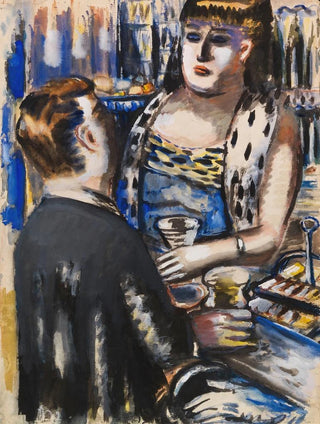Art print | The boss lady - Paul Kleinschmidt


View from behind

Frame (optional)
Art print La patronne - Paul Kleinschmidt – Engaging Introduction
In the vast panorama of art history, certain works stand out for their ability to capture the essence of an era while transcending time. "La patronne" by Paul Kleinschmidt is one such creation that, through its boldness and depth, captivates the viewer and invites reflection on the role of female figures in society. This piece, both simple and complex, evokes a universe where strength and delicacy coexist, making each gaze a journey toward a more nuanced understanding of the human condition.
Style and uniqueness of the work
Kleinschmidt's style is characterized by a subtle blend of realism and expressionism, where forms are both recognizable and imbued with a certain abstraction. "La patronne" illustrates this duality with vibrant colors that breathe new life into the canvas. The features of the characters, though stylized, reveal fascinating psychological depth. The gaze of the protagonist, both determined and contemplative, invites reflection and interpretation. The nuances of light and shadow, skillfully crafted, create an atmosphere that is both intimate and universal, where each viewer can project their own emotions and experiences. This work does not merely depict a female figure; it embodies a strong symbolism, representing female power and authority in a world often dominated by patriarchal norms.
The artist and his influence
Paul Kleinschmidt, a prominent figure of his time, established himself as a visionary artist. His career, marked by diverse encounters and influences, reflects a constant quest for authenticity and innovation. Inspired by the great masters of the past while seeking to renew artistic codes, Kleinschmidt developed a visual language unique to himself. His work, rich in emotion and meaning, contributed to redefining the place of women in art, portraying them not only as muses but as active participants in their narrative. Through "La patronne," he manages to establish a dialogue between the past and the present, bridging the gap between tradition and modernity.

Matte finish

View from behind

Frame (optional)
Art print La patronne - Paul Kleinschmidt – Engaging Introduction
In the vast panorama of art history, certain works stand out for their ability to capture the essence of an era while transcending time. "La patronne" by Paul Kleinschmidt is one such creation that, through its boldness and depth, captivates the viewer and invites reflection on the role of female figures in society. This piece, both simple and complex, evokes a universe where strength and delicacy coexist, making each gaze a journey toward a more nuanced understanding of the human condition.
Style and uniqueness of the work
Kleinschmidt's style is characterized by a subtle blend of realism and expressionism, where forms are both recognizable and imbued with a certain abstraction. "La patronne" illustrates this duality with vibrant colors that breathe new life into the canvas. The features of the characters, though stylized, reveal fascinating psychological depth. The gaze of the protagonist, both determined and contemplative, invites reflection and interpretation. The nuances of light and shadow, skillfully crafted, create an atmosphere that is both intimate and universal, where each viewer can project their own emotions and experiences. This work does not merely depict a female figure; it embodies a strong symbolism, representing female power and authority in a world often dominated by patriarchal norms.
The artist and his influence
Paul Kleinschmidt, a prominent figure of his time, established himself as a visionary artist. His career, marked by diverse encounters and influences, reflects a constant quest for authenticity and innovation. Inspired by the great masters of the past while seeking to renew artistic codes, Kleinschmidt developed a visual language unique to himself. His work, rich in emotion and meaning, contributed to redefining the place of women in art, portraying them not only as muses but as active participants in their narrative. Through "La patronne," he manages to establish a dialogue between the past and the present, bridging the gap between tradition and modernity.






